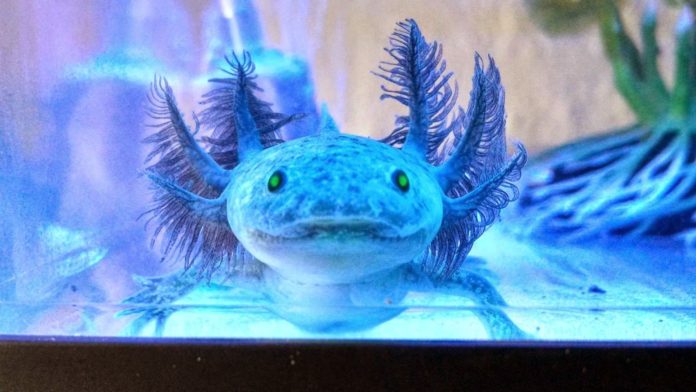Last Updated on January 27, 2024 by Fumipets
Diving into Darkness: The Enigmatic Black Melanoid Axolotl
In the aquatic realm, the axolotl stands as a captivating creature, known for its regenerative abilities and unique appearance. Among the various color morphs of axolotls, the Black Melanoid Axolotl emerges as a particularly mysterious and alluring variant.
With its sleek, dark coloration and distinctive features, the Black Melanoid Axolotl adds a touch of enigma to the fascinating world of amphibians. In this exploration, we unravel the secrets and intricacies surrounding this striking aquatic specimen.
Black Melanoid Axolotl
Since they are not blue at all, the nickname “Blue Axolotl” is inaccurate for this unusual salamander. They may seem blue in certain lighting conditions, but they are really a dark gray or black. The most popular name for them is Black Melanoids.
The Lake Xochimilco and Lake Calcho in southern Mexico City are the home of the axolotl (pronounced AX-oh-lot-ul). It is related to the Aztec deity Xolotl and goes by the name “water dog” in the Nahuatl language of the Aztecs.
Please continue reading if you want to learn more about axolotls and are thinking about getting one for your aquarium.
Quick Facts about the Blue Axolotl
| Species Name: | Ambystoma mexicanum |
| Family: | Ambystomatidae (salamanders) |
| Color Form: | Black or Dark Gray |
| Care Level: | Difficult–Expert |
| Lifespan: | 10–15 years |
| Adult Size: | 10–12 inches |
| Diet: | Worms, pellets |
| Minimum Tank Size: | 20-gallon (needs to be long) |
| Temperature: | 60º–64° F is ideal |

Do Blue Axolotls Make Good Pets?
Given that they are such intriguing animals, axolotls do make wonderful pets. They are observant and inquisitive amphibians that take pleasure in moving about and discovering their surroundings. They don’t mind being seen by their owners, and they may even observe you in return.
Although it might be interesting to watch them move about the aquarium, handling them should only be done when absolutely essential due to their sensitive skin.
Unless you have prior expertise taking care of a tropical freshwater tank, they are not advised for novices.
Appearance
The Black Melanoid Axolotl is known for its distinctive look. These Axolotls are completely dark gray or black, with no other color specks or markings. They seem to be smiling constantly and have fan-shaped, frilly gills on each side of their necks.
These salamanders are also notable for maintaining their limbs, earning them the moniker “Mexican Walking Fish” even though they don’t really walk and spend their whole lives in the water.
The ability of axolotls to regenerate lost limbs is yet another fascinating characteristic. They recover and create new gills, eyes, or limbs if they are lost. amazing small things
In addition to the Black Melanoid, the Axolotl also comes in four other common colors. Although there are more than what we have here, they are quite uncommon.
• Wild: Brownish or brown tint with gold flecks and an undertone of olive green. Only the wild contains them.
• Leucistic: Black eyes and vivid pink or red or pink gills (one of the most popular Axolotls).
• Albino: White with pink or red gills and pink or white eyes.
• Golden Albino: Eyes that are white, pink, or yellow and gills that vary in hue from white to peach, yellow, or a golden orange.
How to Take Care of a Blue Axolotl
Habitat, Tank Conditions & Setup
Tank
A baby Axolotl can live in a 10-gallon tank, while an adult will need a 20-gallon tank. They like to spend some time floating on the surface or wandering along the bottom, thus a longer tank is preferred versus a deeper tank. Having a cover or top is essential since they are rather adept at escaping aquariums.
Water flow must be mild, and the tank will need effective water filtration. Your Axolotl will get stressed and its gills might sustain damage if the water quality is not kept up to the required requirements.
It is crucial to have the proper water quality, and that water should be brackish, which is a mix of fresh and salt water. Use a siphon to remove waste from the substrate, and replace the water once a week by at least 20%. However, never fully drain and clean the water since doing so will upset the delicate equilibrium of the water.
Lighting
Since you cannot alter the temperature, they really need low amounts of light, and the tank must be kept out of direct sunlight.
Temperature
The Black Melanoid Axolotl prefers temperatures between 60° and 64° F. The Axolotl will become sluggish at lower temperatures, while temperatures over 75° F might cause stress and finally death.
Substrate
You may choose between fine sand and no substrate. Small pebbles or gravel should be avoided since an axolotl could consume them and create a barrier. A 3 cm minimum is recommended. You may include soft-textured artificial or genuine flora as well as big boulders for hiding areas. Axolotls have delicate skin that is prone to tearing.
More on Water
Maintaining your Axolotl’s water environment at its ideal state is essential for maintaining its wellbeing. A freshwater aquarium may be established with a pre-mixed formula from a pet shop, therefore you should be comfortable with maintaining one.
You should spend money on a slow filter. Slow-moving, brackish water is required for these amphibians since they are lake dwellers in the wild. You’ll need to replace 20% of the water every day if you don’t buy a filter.
| Tank Recommendations | |
| Tank Type: | 20-gallon tank |
| Lighting: | No direct light. Low light levels |
| Heating: | Keep at 60º to 64° F |
| Water: | Filtered, gentle flow |
| Best Substrate: | Fine sand, large rocks, or bare floor |

How to Feed a Blue Axolotl
You may give your Black Melanoid soft pellets in addition to live food. Live food, however, has the potential to harm your axolotl.
Axolotls should be fed once daily for young ones and once every two to three days for adults.
Bloodworms, nightcrawlers, red wigglers, and soft, moist sinking salmon pellets are suitable foods. Axolotls like to consume anything less than 3 cm, which may include other axolotls, so be sure to only purchase frozen worms for your amphibian and avoid using those intended for fishing since they can contain parasites.
| Diet Summary | |
| Fruits | 0% of diet |
| Insects | 0% of diet |
| Meat | 100% of diet – variety of worms or soft pellets |
| Supplements Required | No |
Keeping Your Blue Axolotl Healthy
Common Health Issues
Ensure that nothing that comes into contact with your Axolotl may harm its sensitive skin. Keep the tank clean since they are prone to parasites and bacterial diseases.
They are susceptible to developing fungus on their gills. If your pet shakes its head a lot, it can be stressed out or suffering from a different illness.
Since they want to consume everything, obstructions in their digestive system are frequent. So once again, be careful not to put any tiny, inedible things in the tank.
Lifespan
The lifespan of axolotls is unusually lengthy. Your Axolotl may survive for up to 15 years if you take excellent care of it by feeding it healthy food and maintaining a clean habitat and water supply.
They aren’t the finest pet for a novice since they need a good bit of upkeep and an experienced owner.
Breeding
While the mating season is normally from March to June, captive Axolotls may breed any time provided the water temperature is sufficient. It is advised to wait until your Axolotls are at least 18 months old.
The male begins to deposit sperm packets throughout the tank after the female and he engage in a kind of dance. After receiving the sperm and internal fertilization, the female will deposit eggs throughout the tank within a few hours or days.
She could lay up to 1,000 eggs, but it’s better to separate them afterward.
Should Blue Axolotls Live in the Same Tank as Other Fish?
No, is the quick response. The Axolotl will just consume any other aquatic fish or amphibians that are smaller. However, there’s also a chance that other fish may gnaw on the feather gills of your axolotl. This will not only harm your Black Melanoid, but it will also make the surroundings stressful. The water’s temperature is also not very friendly to other species.
The ideal tank mate for your adult axolotl is another adult axolotl, but you must make a commitment to feeding both of them to prevent cannibalism.
How Much Do Blue Axolotls Cost?
The cost of the Black Melanoid may vary from $40 to $120 depending on where you get it. Due to delivery costs, this pricing will be greater if you purchase online.
Care Guide Summary
Advantages: fascinating and unique, inquisitive and adventurous, Regenerates limbs when broken, doesn’t need daily feeding
Disadvantages: Needs separate housing; costly, time-consuming, and technical tank setup; easily stressed; requires weekly water changes.
Conclusion
Axolotls are intriguing creatures that have legs and lungs but don’t go onto land. They also have a continuously happy expression and can regrow damaged body parts. An expert aquarist looking for a new pet might choose the stunning Black Melanoid, also known as the Blue Axolotl.
Questions and Answers on the Black Melanoid Axolotl
What Sets the Black Melanoid Axolotl Apart from Other Variants?
The Black Melanoid Axolotl is distinguished by its deep, velvety black coloration. This unique morph is characterized by a complete absence of pigmentation, resulting in a stunningly dark and uniform appearance that sets it apart from other axolotl varieties.
How Does the Black Melanoid Axolotl Differ in Care Requirements?
While the care requirements for the Black Melanoid Axolotl are generally similar to other axolotl variants, their dark coloration may make them more sensitive to light. Providing ample hiding spots and low-light environments is advisable to reduce stress. Additionally, maintaining suitable water parameters and a well-balanced diet remain essential for their overall well-being.
What Size Can the Black Melanoid Axolotl Reach?
Like other axolotls, the Black Melanoid Axolotl is known for its neotenic characteristics, meaning it retains its aquatic juvenile form throughout its life. Typically, they reach a size of 9 to 12 inches, with variations based on factors such as genetics, diet, and environmental conditions.
Are Black Melanoid Axolotls Suitable for Beginners?
Axolotls, including the Black Melanoid variant, are generally considered suitable for beginner amphibian enthusiasts. They are hardy, have straightforward care requirements, and their unique appearance makes them an attractive choice for those entering the world of amphibian keeping.
Can Black Melanoid Axolotls Coexist with Other Axolotl Varieties?
Black Melanoid Axolotls can coexist with other axolotl varieties, provided they are of similar size and have compatible temperaments. However, it’s essential to monitor their interactions and ensure that all axolotls have ample space and resources to prevent territorial disputes.


















